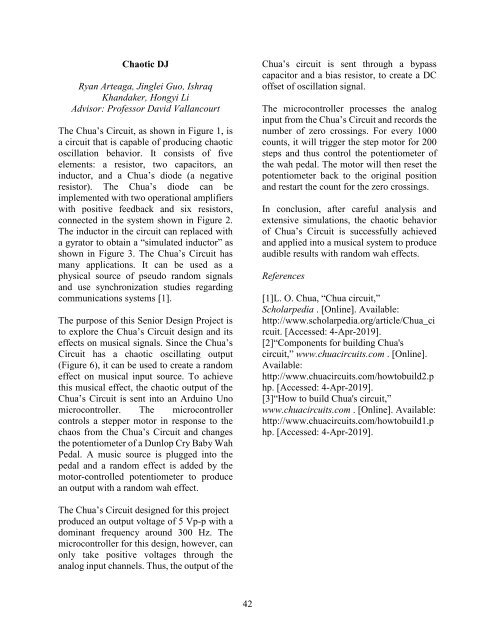Senior Design Expo 2019
The Senior Design Expo, held annually in May at Columbia University, is an opportunity for Columbia Engineering students to showcase what they have learned in their foundational math and science courses together with their engineering courses in innovative, creative, and purposeful designs and prototypes. Each year the Expo showcases more than 60 projects across all nine departments. Projects have included cutting-edge robotics, the New York City subway system, language technology, proposals for bridges to span the Hudson river, and much more.
The Senior Design Expo, held annually in May at Columbia University, is an opportunity for Columbia Engineering students to showcase what they have learned in their foundational math and science courses together with their engineering courses in innovative, creative, and purposeful designs and prototypes. Each year the Expo showcases more than 60 projects across all nine departments. Projects have included cutting-edge robotics, the New York City subway system, language technology, proposals for bridges to span the Hudson river, and much more.
Create successful ePaper yourself
Turn your PDF publications into a flip-book with our unique Google optimized e-Paper software.
Chaotic DJ<br />
Ryan Arteaga, Jinglei Guo, Ishraq<br />
Khandaker, Hongyi Li<br />
Advisor: Professor David Vallancourt<br />
The Chua’s Circuit, as shown in Figure 1, is<br />
a circuit that is capable of producing chaotic<br />
oscillation behavior. It consists of five<br />
elements: a resistor, two capacitors, an<br />
inductor, and a Chua’s diode (a negative<br />
resistor). The Chua’s diode can be<br />
implemented with two operational amplifiers<br />
with positive feedback and six resistors,<br />
connected in the system shown in Figure 2.<br />
The inductor in the circuit can replaced with<br />
a gyrator to obtain a “simulated inductor” as<br />
shown in Figure 3. The Chua’s Circuit has<br />
many applications. It can be used as a<br />
physical source of pseudo random signals<br />
and use synchronization studies regarding<br />
communications systems [1].<br />
The purpose of this <strong>Senior</strong> <strong>Design</strong> Project is<br />
to explore the Chua’s Circuit design and its<br />
effects on musical signals. Since the Chua’s<br />
Circuit has a chaotic oscillating output<br />
(Figure 6), it can be used to create a random<br />
effect on musical input source. To achieve<br />
this musical effect, the chaotic output of the<br />
Chua’s Circuit is sent into an Arduino Uno<br />
microcontroller. The microcontroller<br />
controls a stepper motor in response to the<br />
chaos from the Chua’s Circuit and changes<br />
the potentiometer of a Dunlop Cry Baby Wah<br />
Pedal. A music source is plugged into the<br />
pedal and a random effect is added by the<br />
motor-controlled potentiometer to produce<br />
an output with a random wah effect.<br />
Chua’s circuit is sent through a bypass<br />
capacitor and a bias resistor, to create a DC<br />
offset of oscillation signal.<br />
The microcontroller processes the analog<br />
input from the Chua’s Circuit and records the<br />
number of zero crossings. For every 1000<br />
counts, it will trigger the step motor for 200<br />
steps and thus control the potentiometer of<br />
the wah pedal. The motor will then reset the<br />
potentiometer back to the original position<br />
and restart the count for the zero crossings.<br />
In conclusion, after careful analysis and<br />
extensive simulations, the chaotic behavior<br />
of Chua’s Circuit is successfully achieved<br />
and applied into a musical system to produce<br />
audible results with random wah effects.<br />
References<br />
[1]L. O. Chua, “Chua circuit,”<br />
Scholarpedia . [Online]. Available:<br />
http://www.scholarpedia.org/article/Chua_ci<br />
rcuit. [Accessed: 4-Apr-<strong>2019</strong>].<br />
[2]“Components for building Chua's<br />
circuit,” www.chuacircuits.com . [Online].<br />
Available:<br />
http://www.chuacircuits.com/howtobuild2.p<br />
hp. [Accessed: 4-Apr-<strong>2019</strong>].<br />
[3]“How to build Chua's circuit,”<br />
www.chuacircuits.com . [Online]. Available:<br />
http://www.chuacircuits.com/howtobuild1.p<br />
hp. [Accessed: 4-Apr-<strong>2019</strong>].<br />
The Chua’s Circuit designed for this project<br />
produced an output voltage of 5 Vp-p with a<br />
dominant frequency around 300 Hz. The<br />
microcontroller for this design, however, can<br />
only take positive voltages through the<br />
analog input channels. Thus, the output of the<br />
42








